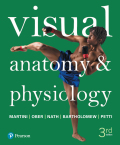
EBK VISUAL ANATOMY & PHYSIOLOGY
3rd Edition
ISBN: 9780134454658
Author: Petti
Publisher: PEARSON CUSTOM PUB.(CONSIGNMENT)
expand_more
expand_more
format_list_bulleted
Question
Chapter 18.1, Problem 31SR
Summary Introduction
To match: Each lettered term with the most closely related description of “Cardiac muscle fiber connections”.
Introduction: The heart is a muscular tissue made up of a special type of striated muscle called cardiac muscle. Though it contracts similar to the skeletal muscle, it is involuntary in nature.
Expert Solution & Answer
Want to see the full answer?
Check out a sample textbook solution
Students have asked these similar questions
a)How is one-way flow through the heart achieved and What are the stages of the cardiac cycle and the changes in pressure that occur in thechambers?b)Define how cardiac output is calculated, and what it can tell you about heart function.
c. What factors influence cardiac output to maintain adequate perfusion?
Identify/describe the structure of the pericardium. Describe its function.
State the location and function of Cardiac center.
Chapter 18 Solutions
EBK VISUAL ANATOMY & PHYSIOLOGY
Ch. 18.1 - Prob. 1RCh. 18.1 - Prob. 2RCh. 18.1 - Prob. 3RCh. 18.1 - Prob. 4RCh. 18.1 - Prob. 5RCh. 18.1 - Prob. 6RCh. 18.1 - The anterior view of the heart is dominated by...Ch. 18.1 - Prob. 8RCh. 18.1 - Name and describe the shallow depressions and...Ch. 18.1 - Prob. 10R
Ch. 18.1 - Prob. 11RCh. 18.1 - Prob. 12RCh. 18.1 - Prob. 13RCh. 18.1 - Prob. 14RCh. 18.1 - Prob. 15RCh. 18.1 - Prob. 16RCh. 18.1 - Prob. 17RCh. 18.1 - Prob. 18RCh. 18.1 - Prob. 19RCh. 18.1 - Prob. 20RCh. 18.1 - Prob. 1LOCh. 18.1 - Prob. 2LOCh. 18.1 - Describe the structure of the pericardium and...Ch. 18.1 - Prob. 4LOCh. 18.1 - Describe the major vessels supplying the heart,...Ch. 18.1 - Prob. 6LOCh. 18.1 - Prob. 7LOCh. 18.1 - Prob. 8LOCh. 18.1 - Prob. 1ICh. 18.1 - Prob. 2ICh. 18.1 - C. Why is it important that cardiac tissue contain...Ch. 18.1 - Prob. 4ICh. 18.1 - Labeing: Label each of the structures in this...Ch. 18.1 - Prob. 2SRCh. 18.1 - Prob. 3SRCh. 18.1 - Prob. 4SRCh. 18.1 - Prob. 5SRCh. 18.1 - Prob. 6SRCh. 18.1 - Prob. 7SRCh. 18.1 - Prob. 8SRCh. 18.1 - Prob. 9SRCh. 18.1 - Prob. 10SRCh. 18.1 - Prob. 11SRCh. 18.1 - Prob. 12SRCh. 18.1 - Prob. 13SRCh. 18.1 - Prob. 14SRCh. 18.1 - Prob. 15SRCh. 18.1 - Prob. 16SRCh. 18.1 - Prob. 17SRCh. 18.1 - Prob. 18SRCh. 18.1 - Prob. 19SRCh. 18.1 - Prob. 20SRCh. 18.1 - Prob. 21SRCh. 18.1 - Prob. 22SRCh. 18.1 - Prob. 23SRCh. 18.1 - Prob. 24SRCh. 18.1 - Prob. 25SRCh. 18.1 - Prob. 26SRCh. 18.1 - Prob. 27SRCh. 18.1 - Prob. 28SRCh. 18.1 - Prob. 29SRCh. 18.1 - Prob. 30SRCh. 18.1 - Prob. 31SRCh. 18.1 - Prob. 32SRCh. 18.1 - Matching: Match each lettered term with the most...Ch. 18.1 - Prob. 34SRCh. 18.1 - Prob. 35SRCh. 18.2 - Prob. 1RCh. 18.2 - Prob. 2RCh. 18.2 - Prob. 3RCh. 18.2 - Prob. 4RCh. 18.2 - Why does tetany not occur in cardiac muscle?
Ch. 18.2 - Prob. 6RCh. 18.2 - Prob. 7RCh. 18.2 - Prob. 8RCh. 18.2 - Prob. 9RCh. 18.2 - Prob. 10RCh. 18.2 - Prob. 11RCh. 18.2 - Prob. 12RCh. 18.2 - Prob. 13RCh. 18.2 - Prob. 14RCh. 18.2 - Prob. 15RCh. 18.2 - Prob. 16RCh. 18.2 - Prob. 1LOCh. 18.2 - Prob. 2LOCh. 18.2 - Prob. 3LOCh. 18.2 - Prob. 4LOCh. 18.2 - Prob. 5LOCh. 18.2 - Describe the factors affecting the heart rate.
Ch. 18.2 - Prob. 7LOCh. 18.2 - Prob. 8LOCh. 18.2 - Prob. 1ICh. 18.2 - Prob. 2ICh. 18.2 - Prob. 3ICh. 18.2 - Prob. 4ICh. 18.2 - Prob. 5ICh. 18.2 - Prob. 1SRCh. 18.2 - Prob. 2SRCh. 18.2 - Prob. 3SRCh. 18.2 - Prob. 4SRCh. 18.2 - P wave
cardiac output
autorhythmicity
“lubb”...Ch. 18.2 - Prob. 6SRCh. 18.2 - Prob. 7SRCh. 18.2 - Prob. 8SRCh. 18.2 - Prob. 9SRCh. 18.2 - Prob. 10SRCh. 18.2 - Prob. 11SRCh. 18.2 - Prob. 12SRCh. 18.2 - Prob. 13SRCh. 18.2 - Prob. 14SRCh. 18.2 - Prob. 15SRCh. 18.2 - Prob. 16SRCh. 18.2 - Prob. 17SRCh. 18 - Prob. 1CRQCh. 18 - Prob. 2CRQCh. 18 - Prob. 3CRQCh. 18 - Prob. 4CRQCh. 18 - Prob. 5CRQCh. 18 - Prob. 6CRQCh. 18 - Prob. 7CRQCh. 18 - Prob. 8CRQCh. 18 - Prob. 9CRQCh. 18 - Prob. 10CRQCh. 18 - Prob. 11CRQCh. 18 - Prob. 12CRQCh. 18 - Prob. 13CRQCh. 18 - Prob. 14CRQCh. 18 - Prob. 15CRQCh. 18 - Prob. 16CRQCh. 18 - Prob. 17CRQCh. 18 - Prob. 18CRQCh. 18 - Prob. 19CRQCh. 18 - Prob. 20CRQCh. 18 - Prob. 1CICh. 18 - Prob. 2CICh. 18 - Prob. 3CI
Knowledge Booster
Learn more about
Need a deep-dive on the concept behind this application? Look no further. Learn more about this topic, biology and related others by exploring similar questions and additional content below.Similar questions
- Explain the term isovolumetric ventricular contraction?arrow_forwardMatch the following: ? Prevents backflow into the left ventricle ? Prevents backflow into the right atrium ? Prevents backflow into the left atrium ? Prevents backflow into the right ventricle A. Aortic semilunar valve B. Mitral (bicuspid) valve C. Tricuspid valve D. Pulmonary semilunar valvearrow_forward. Discuss the heart sounds and their significance.arrow_forward
arrow_back_ios
SEE MORE QUESTIONS
arrow_forward_ios
Recommended textbooks for you
 Fundamentals of Sectional Anatomy: An Imaging App...BiologyISBN:9781133960867Author:Denise L. LazoPublisher:Cengage Learning
Fundamentals of Sectional Anatomy: An Imaging App...BiologyISBN:9781133960867Author:Denise L. LazoPublisher:Cengage Learning Human Biology (MindTap Course List)BiologyISBN:9781305112100Author:Cecie Starr, Beverly McMillanPublisher:Cengage Learning
Human Biology (MindTap Course List)BiologyISBN:9781305112100Author:Cecie Starr, Beverly McMillanPublisher:Cengage Learning

Fundamentals of Sectional Anatomy: An Imaging App...
Biology
ISBN:9781133960867
Author:Denise L. Lazo
Publisher:Cengage Learning

Human Biology (MindTap Course List)
Biology
ISBN:9781305112100
Author:Cecie Starr, Beverly McMillan
Publisher:Cengage Learning
The Cardiovascular System: An Overview; Author: Strong Medicine;https://www.youtube.com/watch?v=Wu18mpI_62s;License: Standard youtube license